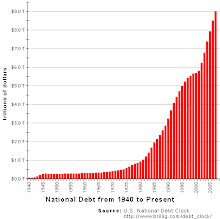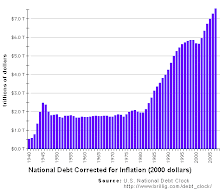 Click on the image above to enlarge it.
Click on the image above to enlarge it.The Budget of the United States Government provides a breakdown of federal government spending by category.
The President's budget for 2010 totals $3.55 trillion. Percentages in parentheses indicate percentage change compared to 2009. This budget request is broken down by the following expenditures:
Mandatory spending: $2.184 trillion (+15.6%)
$695 billion (+4.9%) - Social Security
$453 billion (+6.6%) - Medicare
$290 billion (+12.0%) - Medicaid
$0 billion (-100%) - Troubled Asset Relief Program (TARP)
$0 billion (-100%) - Financial stabilization efforts
$11 billion (+275%) - Potential disaster costs
$571 billion (-15.2%) - Other mandatory programs
$164 billion (+18.0%) - Interest on National Debt
Discretionary spending: $1.368 trillion (+13.1%)
$663.7 billion (+12.7%) - Department of Defense (including Overseas Contingency Operations)
$78.7 billion (-1.7%) - Department of Health and Human Services
$72.5 billion (+2.8%) - Department of Transportation
$52.5 billion (+10.3%) - Department of Veterans Affairs
$51.7 billion (+40.9%) - Department of State and Other International Programs
$47.5 billion (+18.5%) - Department of Housing and Urban Development
$46.7 billion (+12.8%) - Department of Education
$42.7 billion (+1.2%) - Department of Homeland Security
$26.3 billion (-0.4%) - Department of Energy
$26.0 billion (+8.8%) - Department of Agriculture
$23.9 billion (-6.3%) - Department of Justice
$18.7 billion (+5.1%) - National Aeronautics and Space Administration
$13.8 billion (+48.4%) - Department of Commerce
$13.3 billion (+4.7%) - Department of Labor
$13.3 billion (+4.7%) - Department of the Treasury
$12.0 billion (+6.2%) - Department of the Interior
$10.5 billion (+34.6%) - Environmental Protection Agency
$9.7 billion (+10.2%) - Social Security Administration
$7.0 billion (+1.4%) - National Science Foundation
$5.1 billion (-3.8%) - Corps of Engineers
$5.0 billion (+100%) - National Infrastructure Bank
$1.1 billion (+22.2%) - Corporation for National and Community Service
$0.7 billion (0.0%) - Small Business Administration
$0.6 billion (-14.3%) - General Services Administration
$19.8 billion (+3.7%) - Other Agencies
$105 billion - Other
SIX CATEGORIES OF SPENDING COMPRISE MORE THAN 75% OF THE U.S. FEDERAL BUDGET:
Social Security
Medicare
Medicaid and the State Children's Health Insurance Program (SCHIP)
Unemployment/Welfare/Other mandatory spending
Interest on National Debt
Department of Defense
SERIOUS DISCUSSIONS ABOUT REDUCING THE SIZE AND SCOPE OF FEDERAL GOVERNMENT SPENDING MUST ADDRESS THESE CATEGORIES.







